Multimedia features
For an audio slideshow about this story, click on the box at right. See a photo gallery here, click here for videos of local dancers in action.
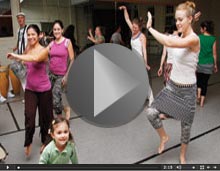
From spicy salsa dance classes to graceful Argentine tango and powerful Afro-Brazilian samba, Asheville boasts an ever-growing Latin American dance scene. And with more local and regional dancers drawn to class each year, the word is getting around.
The eclectic flavor of Havana’s Rueda de Casino, a style of Cuban salsa, comes to life in the studio, where Latin dance company Salseros 828 breaks down each choreographed flourish. The subtle art of Argentine tango, an intimate partner dance, is explored on the dance floor with members of Tango Asheville and Tango Gypsies. And a fusion between African dance and Brazilian samba is taught each week in the River Arts District, where musicians fill the space with eclectic rhythms.
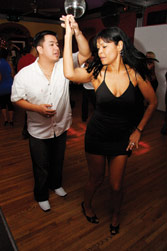
These companies and teachers offer weekly classes and social practicas, where dancers of all ages, races, body types and skill levels connect and communicate through movement. Each form has its own cultural history, with a personality that makes it unique. The question is finding the dance that inspires you the most.
Salseros 828
Vibrant and alluring, salsa speaks a language of its own. As dancers whirl across the floor with fast footwork and precise turns, they engage in a sultry duet, a conversation held in physical form.
Salsa, which literally translates to “spicy sauce,” blends together Caribbean and Cuban dance forms, creating a flirtatious and sexy dance that has captivated the world over—from casinos in Havana to nightclubs in Seoul, South Korea.
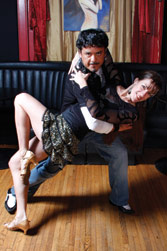
Here in Asheville, the Latin dance company Salseros 828 keeps the salsa scene thriving. “Salsa and Latin dance in general is open to every type of person, every body type, age, race or social group,” says Maria Voisin, the founder of Salseros 828. “It is a uniting dance that draws one of the most diverse crowds in town.”
Established in 2002, Salseros 828 teaches and performs a number of Latin dance styles including merengue, mambo and many forms of salsa. The company has two groups that perform professionally: a co-ed company and a women’s company called Dulcinea, which takes its name from Don Quixote’s fantasy girl in Miguel de Cervantes’ epic. Advanced dancers must audition or be invited to join the performing troupes.
While studying at the National School of the Arts in Havana, Voisin honed her skills in Cuban salsa, a style known as Rueda de Casino. “This style started in the casinos in Havana, and the dance imitates the visuals of the casino, especially the roulette wheel,” she says. “It’s highly choreographed movement that’s fun, sexy and entertaining.”
The company also teaches the Los Angeles and New York styles of salsa. “Think of L.A.,” says Voisin, “it’s a city very much about performance. The L.A. style is flashy, with lots of tricks, lots of drama and emotion, and all emphasis and accents are on the downbeat.

“In New York, it’s more about the precision of movement and musicality, with accents on the upbeat. They are mimicking what they hear in the music. The movement itself is influenced [by] jazz and swing, so it pulls a lot of different forms together.”
With salsa, the atmosphere in the studio differs greatly from the social gatherings. In class, dancers are encouraged dress casually, in flexible exercise clothing suitable for sweating. Women practice in high-heels, soft-soled dance shoes or slippers. Visit salsa night at Eleven on Grove, on the other hand, and you’ll find dancers dressed to impress. Men wear collared shirts, jackets and freshly shined shoes, while women sport sexy evening wear and precariously high heels. No partners are needed at class or at the club.
Studying salsa will enhance all areas of your life, emphasizes Hector Gutierrez, a teacher and principal dancer with Salseros 828. “We use salsa like therapy, to become more confident about yourself and [gain] more understanding of your body.”
“It has changed my personality,” adds Deyanira Chavez, a principal dancer with Salseros 828. “Salsa teaches you how to present yourself, to stand straight with confidence; it becomes part of who you are.”
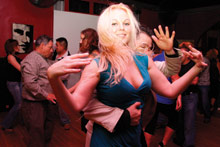
Tango Asheville and Tango Gypsies
Standing cheek to cheek in an elegant embrace, tango partners hold each other closely and close their eyes, waiting for the music to guide them into motion. Argentine tango begins with a gentle impulse, and continues with sultry waltz-like steps that carry the dancers in spirals across the floor.
This graceful social dance was born in the river cities of Buenos Aires, Argentina, and Montevideo, Uruguay, where it flourished among working-class communities. Since then, it has developed in cities and nightclubs across South and North America, Europe and Asia.
Here in Asheville, an extensive community of dancers devote themselves to mastering this chic, partner-focused dance. Tango Asheville, a club boasting more than 70 members, meets twice weekly for social dancing practicas—where beginners and advanced dancers take their skills to the dance floor. At the practicas, a lead dancer (usually the male dancer, but not exclusively) initiates the choreography and guides the dance, while the follower responds, reading the quiet gestures of the leader.
“Argentine tango is improvisational and natural,” describes Larry Gant, the club’s chairman and a seasoned dancer. “It is less formal than ballroom dance styles because there are no memorized sequences of steps. Tango is like a physical and emotional conversation set to music.”
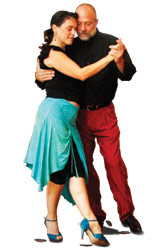
Established in 2001, the club serves as a community resource for those with experience or interest in Argentine tango. “It’s a dance space open to anyone from anywhere,” says Gant. “Each week, the club attracts a diverse group of people—engineers, accountants, artists, young people, older people: all gathered for a shared passion.”
Those interested in attending Tango Asheville’s weekly practicas are encouraged to dress formally for the occasion. No partners are needed to attend, as everyone takes turns dancing with each other. All skill levels are welcome.
For classes and instruction, the club refers to Karen Jaffe, a professional dancer and the founder of Tango Gypsies. “The wonderful thing about tango is that you can move anywhere at any given time,” says Jaffe, who started teaching in Asheville in 1997. “There are no mistakes, no absolutions. It’s about connecting with a partner, listening to the music and being able to move with the music.”
As a teacher, Jaffe focuses on the fundamentals of tango, which she describes as sensitivity, posture, embrace, musicality and confidence. “My teaching philosophy is, ‘Less is more.’ I encourage my students to find a quiet baseline to be able to read the subtle impulses of their partner. It can be intimidating, but it’s so rewarding.” She also teaches weekly milonga classes, a style of Argentine tango influenced by Spanish and African traditions. For all classes and styles, dancers are welcome to come alone or with a partner.

More than just a dance, the challenges and lessons of tango can inform all aspects of life, explains Jaffe. “The goal is to enjoy the dance, and to let it teach you something about yourself.”
Afro-Brazilian Samba
The music and dance of two distant cultures come together in an eclectic, energizing dance form known as Afro-Brazilian samba. “This is not a mainstream samba class,” says Jessica Telfair, who has been teaching ethnic dance for more than a decade. “This is a fusion between African music and dance and Brazilian samba; it’s rooty, sensual and strongly feminine.” Unlike the flashy samba seen in Rio de Janeiro, Brazil, during Carnaval, this form of samba is strongly rooted in African traditions.
The origins of Afro-Brazilian samba stretch back to the time of the slave trade, when Africans from the Congo, Benin, Angola and Nigeria were brought to Brazil. In the city of Bahia, African culture merged with Portuguese, creating an innovative dance culture that blends powerful African dance with sultry Brazilian rhythms.
Ready to dance? Info you need
Salsa
Class schedule: Drop in anytime, no partner needed.
• Mondays: Afro-Cuban Dance from 6:30 to 7:30 p.m.; Technique and Spins for Salsa from 7:30 to 8:30 p.m. $12 per class/ Multiple class discounts available. Held at Terpsicorps Dance Studio, 129 Roberts St. in the River Arts District.
• Wednesdays: Absolute Beginner Salsa, from 6:30 to 7:30 p.m.; Salsa Beginner Level 2 from 7:30 to 8:30 p.m.; Salsa Intermediate Level from 8:30 to 9:30 p.m. (These are six-week salsa courses held at Terpsicorps Dance Studio. The next series of classes begin on Jan. 7. Register now as classes fill fast.)
• Friday Nights: Salsa Palante Dance Night and Latin Social Dancing, starting at 10:30 p.m. at Eleven on Grove, 11 Grove St., Asheville.
Info: www.salseros828.com.
Tango Asheville’s practicas:
• Saturdays: Argentine Tango and Milonga from 7:30 to 10:30 p.m. at Filos, 1155 Tunnel Road.
• First Sundays of the month: Argentine Tango from 7 to 10 p.m. at the Asheville Arts Center, 308 Merrimon Ave.
• Every Sunday (except the first of the month): Argentine Tango from 7 to 10 p.m. at the North Asheville Center, 37 East Larchmont Drive. $5 per night or $15 for a year-long membership. Info: www.tangoasheville.com.
Classes with Karen Jaffe:
• Tango Tuesdays, starting at 7 p.m. Milonga classes begin at 8:30 p.m. Held at Club Eleven, 11 Grove St. $10 for the evening/ $7 for a single class. Info: www.tangogypsies.com.
Afro-Brazilian Samba:
• Every other Thursday at 7 p.m. at Terpsicorps in the River Arts District. $10. Info: jesstel@bellsouth.net.
In the spacious Terpsicorp Dance Studio located in the River Arts District, a dance community dedicated to Afro-Brazilian samba flourishes. “This is not just a dance class,” emphasizes Telfair. “It’s a communal event, where people come together to make music and dance. It’s about being together and being connected.”
Giving the class an exciting edge—and a powerful musical atmosphere—are the live drummers with Zabumba who perform throughout the entire class. Zabumba, named after a Brazilian drum, specializes in Afro-Brazilian drumming and rhythms. “The music is based on Portuguese military drumming,” says Allen Frost, the founder of the troupe, and a self-described Hurricane Katrina transplant. “We use mallets and sticks, snare drums and bass drums, giving us a military marching-band feel.” Though the troupe is relatively new to Asheville, they have certainly found their niche.
Dancers of all levels are welcome at class and should dress in comfortable active wear. Following an African tradition, women often wear loose wrap-around skirts that are tied at the waistline. No shoes are needed.
Having live musicians perform for class allows for greater artistic opportunity, for both the musicians and the dancers, says Telfair. “People crave this kind of exchange. And, when you are dancing to live music you really feel it; it teaches you about musicality.”
“This class is celebratory and unifying,” adds Sariya, a class regular. “The best part about it is that everyone can do it.”
All video footage shot by Aiyanna Sezak-Blatt.
Thanks for reading through to the end…
We share your inclination to get the whole story. For the past 25 years, Xpress has been committed to in-depth, balanced reporting about the greater Asheville area. We want everyone to have access to our stories. That’s a big part of why we've never charged for the paper or put up a paywall.
We’re pretty sure that you know journalism faces big challenges these days. Advertising no longer pays the whole cost. Media outlets around the country are asking their readers to chip in. Xpress needs help, too. We hope you’ll consider signing up to be a member of Xpress. For as little as $5 a month — the cost of a craft beer or kombucha — you can help keep local journalism strong. It only takes a moment.
Before you comment
The comments section is here to provide a platform for civil dialogue on the issues we face together as a local community. Xpress is committed to offering this platform for all voices, but when the tone of the discussion gets nasty or strays off topic, we believe many people choose not to participate. Xpress editors are determined to moderate comments to ensure a constructive interchange is maintained. All comments judged not to be in keeping with the spirit of civil discourse will be removed and repeat violators will be banned. See here for our terms of service. Thank you for being part of this effort to promote respectful discussion.



Kudos on the whole package, words, images, rhythm, music — and passion. Salsa therapy and all the other therapies are greatly present.
How much for private Tango lessons for a couple?